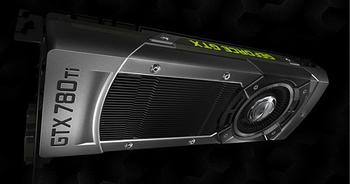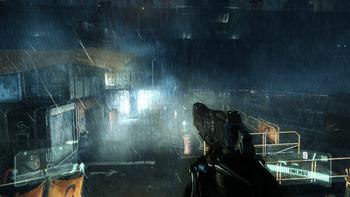Nvidia's high-end graphics cards have held a seemingly unassailable performance lead for most of this year. The GeForce GTX Titan came in swinging in February and smashed all before it. Nvidia followed this up with the slightly slower GeForce GTX 780 in May, and the green team has had the premium market all to itself until a few weeks ago. Due to an honest lack of competition, this performance monopoly has meant the return of the £500-plus cards.
AMD Radeon R9 290X and 290 have finally arrived on the scene and matched, or even exceeded, Nvidia's performance, particularly when gaming at high resolutions, with the added benefit of being cheaper than the comparison GeForces. Now, in a two-pronged attack at wrestling back the hearts, minds and wallets of the enthusiast, Nvidia has taken an axe to GeForce GTX 780 and GTX 770 pricing, making them somewhat comparable with AMD's offerings, and promised a new benchmarking-topping card in the form of the $699 GeForce GTX 780 Ti.
Today, we reveal just how Nvidia intends to regain or reinforce - depending upon how you construe current benchmark results - its position as the provider of the best gaming graphics cards on the market.
Nvidia has three paths that it can take to advance the performance of the current GeForce GTX 780: it can increase the core and memory frequencies - this works really rather well with partner cards - boost the number of shader-units, or do both. After having seen the performance of the Radeon R9 290X, which is roughly analogous to the GTX Titan, Nvidia has decided to take that third path. Let's show you how with the usual Table of Doom.
| GPU | Nvidia GeForce GTX Titan 6GB | Nvidia GeForce GTX 780 Ti 3GB | Nvidia GeForce GTX 780 3GB | Radeon R9 290X 4GB | Radeon R9 290 4GB |
|---|---|---|---|---|---|
| Launch date | February 2013 | November 2013 | May 2013 | October 2013 | November 2013 |
| DX API | 11.1 | 11.1 | 11.1 | 11.2 | 11.2 |
| Process | 28nm | 28nm | 28nm | 28nm | 28nm |
| Transistors | 7.1bn | 7.1bn | 7.1bn | 6.2bn | 6.2bn |
| Approx Die Size | 551mm² | 551mm² | 551mm² | 438mm² | 438mm² |
| SMX Units | 14 | 15 (full) | 12 | NA | NA |
| Processors | 2,688 | 2,880 | 2,304 | 2,816 | 2,560 |
| Texture Units | 224 | 240 | 192 | 176 | 160 |
| ROP Units | 48 | 48 | 48 | 64 | 64 |
| GPU Clock/Boost (MHz) | up to 876 | up to 928 | up to 902 | up to 1,000 | up to 947 |
| Shader Clock/Boost (MHz) | up to 876 | up to 928 | up to 902 | up to 1,000 | up to 947 |
| GFLOPS | up to 4,494 | up to 5,345 | up to 4,156 | up to 5,632 | up to 4,849 |
| Memory Clock (MHz) | 6,000 | 7,000 | 6,000 | 5,000 | 5,000 |
| Memory Bus (bits) | 384 | 384 | 384 | 512 | 512 |
| Max bandwidth (GB/s) | 288.4 | 336.5 | 288.4 | 320 | 320 |
| Power Connectors | 8+6-pin | 8+6-pin | 8+6-pin | 8+6-pin | 8+6-pin |
| TDP (watts) | 250 | 250 | 250 | 250 | 250 |
| GFLOPS per watt | 17.98 | 21.38 | 16.62 | 22.52 | 19.40 |
| Current price | $999 | $699 | $499 | $549 | $449 |
Architecture analysis - the full-fat GeForce GTX 780 Ti
You'll likely know the GTX 780 uses an incomplete GK110 die. The full-fat implementation calls for 15 SMX units; Titan uses 14 and GTX 780 12, with each containing 192 shaders and 16 texture units. GTX 780 Ti, meanwhile, increases this to the maximum 15 supported by the Kepler architecture. Yup, this is Nvidia going for an all-out performance assault on the nascent Radeons.
Nvidia also boosts the GPU Boost speed to a supported 928MHz, though, going by previous experiences, the GPU may well run faster when gaming. Crunching the official numbers shows that GTX 780 Ti has, via architecture and frequency, 19 per cent more shading power than said Titan. Keeping all this extra shading power requires an upgrade to the backend of the GPU, so Nvidia increases the memory speed from 6,000MHz to 7,000MHz - an uptick of almost 17 per cent.
Though it's clear that GeForce GTX 780 Ti will be a fair bit faster than Titan in games, by dint of its processing and memory advantages, do note that it ships with a 3GB framebuffer, implemented to keep costs in check and Nvidia's profit margins high. GTX Titan remains the premier card in our minds, equipped with a 6GB buffer and massively higher double-precision throughput, but it is also $300 dearer.
Expressed in pure gaming terms, the GeForce GTX 780 Ti is the fastest card ever built by Nvidia. It's highly unlikely that Nvidia will release a faster reference GPU based on the present Kepler architecture, for it has used all available architecture resources in constructing the GTX 780 Ti.
The question of GeForce hegemony is moot; the one that matters is whether this GeForce, representing the pinnacle of Kepler GPU engineering, has enough chutzpah to overcome the AMD Radeon R9 290X - which, let's not forget, is $150 cheaper. Let's find out, shall we?
GPU Comparisons |
|||||||
|---|---|---|---|---|---|---|---|
| Graphics Card | Peak GPU Clock (MHz) |
Stream Processors |
Peak Shader Clock (MHz) |
Memory Clock (MHz) |
Memory Bus (bits) |
Graphics Driver | |
| Nvidia GeForce GTX Titan 6GB | 876 | 2,688 | 876 | 6,008 | 384 | GeForce 331.40 | |
| Nvidia GeForce GTX 780 Ti 3GB | 928 | 2,880 | 928 | 7,012 | 384 | GeForce 331.70 | |
| Nvidia GeForce GTX 780 3GB | 900 | 2,304 | 900 | 6,008 | 384 | GeForce 331.40 | |
| Nvidia GeForce GTX 770 2GB | 1,085 | 1,536 | 1,085 | 7,012 | 256 | GeForce 331.40 | |
| Nvidia GeForce GTX 760 2GB | 1,033 | 1,152 | 1,033 | 6,008 | 256 | GeForce 331.40 | |
| Nvidia GeForce GTX 670 2GB | 980 | 1,344 | 980 | 6,008 | 256 | GeForce 331.40 | |
| Nvidia GeForce GTX 660 2GB | 1,032 | 960 | 1,032 | 6,008 | 192 | GeForce 331.40 | |
| Nvidia GeForce GTX 650 Ti Boost 2GB | 1,032 | 768 | 1,032 | 6,008 | 192 | GeForce 331.40 | |
| AMD Radeon R9 290X 4GB | 1,000 | 2,816 | 1,000 | 5,000 | 512 | Catalyst 13.11 v8 | |
| AMD Radeon R9 290 4GB | 947 | 2,560 | 947 | 5,000 | 512 | Catalyst 13.11 v8 | |
| AMD Radeon R9 280X 3GB | 1,000 | 2,048 | 1,000 | 6,000 | 384 | Catalyst 13.11 | |
| AMD Radeon HD 7970 GE 3GB | 1,050 | 2,048 | 1,050 | 6,000 | 384 | Catalyst 13.11 | |
| AMD Radeon HD 7950 3GB | 800 | 1,792 | 800 | 5,000 | 384 | Catalyst 13.11 | |
| AMD Radeon R9 270X 2GB | 1,050 | 1,280 | 1,050 | 5,600 | 256 | Catalyst 13.11 | |
| AMD Radeon HD 7870 2GB | 1,000 | 1,280 | 1,000 | 4,800 | 256 | Catalyst 13.11 | |
| AMD Radeon R7 260X 2GB | 1,100 | 896 | 1,100 | 6,400 | 128 | Catalyst 13.11 | |
HEXUS Graphics Test Bench |
|
|---|---|
| Processor | Intel Core i7-4770K (3.50GHz, 8MB cache, quad-core) |
| CPU Cooler | Intel reference E97378-001 |
| Motherboard | Gigabyte GA-Z87X-UD3H |
| Memory | 16GB G.Skill RipJaws (2x8GB) DDR3 @ 1,600MHz |
| Power Supply | Corsair AX760i |
| Storage Device | Samsung 840 Series 256GB SSD |
| Chassis | Corsair Graphite Series 600T |
| Monitor | Philips Brilliance 272P (2,560x1,440) |
| Operating system | Windows 8 64-bit |
HEXUS High-End Benchmark Suite |
||
|---|---|---|
| GPU Benchmarks | Mode and Resolutions | Quality Settings |
| 3DMark | DX11 at 1,920x1,080 and 2,560x1,440 | Fire Strike and Fire Strike Extreme |
| BioShock Infinite | DX11 at 1,920x1,080 and 2,560x1,440 | Ultra + DOF |
| Crysis 3 | DX11 at 1,920x1,080 and 2,560x1,440 | 4xMSAA, High Preset |
| Far Cry 3 | DX11 at 1,920x1,080 and 2,560x1,440 | 2xMSAA, Ultra Preset |
| GRID 2 | DX11 at 1,920x1,080 and 2,560x1,440 | 4xMSAA, Ultra Preset |
| Just Cause 2 | DX10 at 1,920x1,080 and 2,560x1,440 | 8xMSAA, High Preset |
| Total War: Rome II | DX11 at 1,920x1,080 and 2,560x1,440 | 4xMSAA, High Preset |
| General Benchmarks | Description | |
| Power Consumption | To emulate real-world usage scenarios, we record mains power draw both when idle and while playing Far Cry 3 | |
| Temperature | To emulate real-world usage scenarios, we record GPU core temperature both when idle and while playing Far Cry 3 | |
| Noise | A PCE-318 meter is used to record noise levels when idle and while playing Far Cry 3 | |
Notes
We're using the very latest drivers for the GeForce GTX 780 Ti and Radeon R9 290(X) GPUs. AMD's 290X has been benchmarked in both standard and uber modes.
3DMark is the latest version of this hugely-popular synthetic benchmark. Making use of DX11 features such as tessellation, compute shaders and multi-threading, it provides modern-day results and is available as a free download.
The Radeon R9 290X held a reasonable lead over the GeForce GTX Titan in 3DMark, which tends to favour the red team. The full-architecture GTX 780 Ti pulls just ahead at the standard resolution but lags a mite behind at the extreme preset.
Making a really good case for game of the year already, BioShock is fantastically playable and looks great on the PC. We benchmark a 30-second section near the start.
The erstwhile Nvidia champ, GTX Titan, lost out to the R290X at the 2,560x1,440 resolution. GTX 780 Ti's extra muscle, on both core and memory, brings the BioShock Infinite performance crown back to Nvidia. It is the only GPU capable of averaging 60fps.
The per-second results show that the GTX 780 Ti provides best-in-class performance.
Crysis 3 is a beautiful-looking game that continues to tax high-end systems. We've FRAPS'd a 30-second section near the start of the game, with lashing rain, numerous reflections and full DX11 pomp on show.
GTX Titan just about fended the R9 290X threat off in Crysis 3; GTX 780 Ti leapfrogs the Titan into first place.
And it holds a circa-10 per cent framerate advantage over the R9 290X.
 |
Homepage: Far-cry.ubi.com | Publisher and Developer: Ubisoft.com |
Open-world gaming at its very best, Far Cry 3 redefines the genre through breathtaking visuals and first-class gameplay.
Radeon R9 290X got within touching distance of the Titan, but the extra visceral power of the GTX 780 Ti really shows itself in this title. We can't imagine that AMD will be able to overcome Nvidia's newest card in this title.
Yup, the gap's pretty big here.
 |
Homepage: gridgame.com.com | Publisher and Developer: Codemasters.com |
Amazing graphics and buttery-smooth gameplay makes GRID 2 one of the best racers around.
AMD gave Nvidia a good beating in GRID 2, especially considering the price of the two high-end cards. GTX 780 Ti manages to eke ahead of the R9 290X, and adds around 10 per cent to the Titan's framerate at 2,560x1,440.
GeForce GTX 780 Ti reverses Nvidia's fortunes in this title. You'd still do well to remember that AMD's card costs $150 less than Nvidia's table-topper.
Just Cause 2 is one of the older titles in our suite and uses DX10 visuals. It's no longer cutting edge, but it's still a lot of fun and can be used to cross-reference older reviews.
Here's a strange one, as the extra power of the GTX 780 Ti over the Titan doesn't manifest itself with appropriately higher framerates. Indeed, the GTX 780 Ti is beaten by a Radeon R9 290.
For the first time in the benchmarks thus far, the red line is consistently above the green.
Providing an excellent mix of strategy and action, Total War: Rome II's epic turn-based gameplay can swallow hours of your life.
Total War: Rome II, on the other hand, can use as much graphical power as you can throw at it. The difference between GTX 780 Ti and GTX Titan is very telling at 2,560x1,440.
Thus making Nvidia's fastest gaming card run at about the same speed as the Radeon R9 290X.
Activating more cores and running a substantially higher memory clock is all well and good for performance, but there is an inevitable price to pay with respect to energy consumption. As a system, the GTX 780 Ti consumes about 40W more than a GTX Titan.
Nvidia's power-control mechanism still tries to keep the GPU running at what it deems a safe temperature, which is about 80°C. No 95°C shenanigans here, eh, AMD?
And by using the same cooling design as present on GTX Titan and GTX 780, the one downside is that, under full tilt, the GTX 780 Ti is a little louder. Our logs show the fan spins at around 2,500rpm, compared to 2,200rpm for the Titan when running the same load.
Pushing it further, we increased the power target to the maximum 106 per cent and then raised the core and memory clocks without tampering with the card's voltage. The end result? A base core speed of 966MHz and memory blitzing along at an effective 7,720MHz.
Click on the picture for a bigger version. The overclocked GTX 780 Ti benchmarks in 3DMark at about the same speed as the overclocked Radeon R9 290.
Though it has no peer when running through Far Cry 3. 100fps at ultra settings, anyone?
Nvidia has brought the full force of its Kepler GK110 GPU architecture to bear with the GeForce GTX 780 Ti card released today. The company is throwing everything it can, including the kitchen sink, at AMD.We begin by thanking AMD for bringing much-needed competition into the enthusiast graphics card space. It is highly doubtful that we would have been witness to substantial price reductions and arrival of the GeForce GTX 780 Ti had AMD not come in fast and hard.
Nvidia has brought the full force of its Kepler GK110 GPU architecture to bear with the GeForce GTX 780 Ti card released today. The company is throwing everything it can, including the kitchen sink, at AMD.
We tentatively gave AMD's R9 290X the mantle of world's fastest consumer graphics card. Nvidia wrestles it away just two weeks later by pushing the GTX 780 Ti to the limit of what's currently viable with its own GPU technology. Providing more context, our benchmarks show that GTX 780 Ti is up to 20 per cent faster than the non-Ti card that's been available for the past six months, though do appreciate that partners have already achieved GTX 780 Ti-like speeds by overclocking the standard GPU to to the hilt.
Nvidia's fastest card is likely to arrive on these shores priced from £550, or £100 more than the R9 290X that it eclipses in benchmarks. Whether this constitutes good value depends upon the games you play and how you view Nvidia's latest three-game bundle - AMD doesn't provide any games with R9 290X.
GeForce GTX 780 Ti is the epitome of GPU brinkmanship; Nvidia's hand has been forced and it fights the only way it know how: to push back even harder. The cynic in us wanted this GPU available in May, rather than the hobbled version that was presented to us, but later is better than never.
Ideally suited to playing the latest games at high resolutions and image-quality settings, the GeForce GTX 780 Ti makes a very strong case for inclusion in the ultimate PC build.
The Good
Class-leading performance
Uses elegant reference designThe Bad
3GB frame buffer may not be that future proof
HEX US. awards
HEXUS.where2buy
The AMD Rad eon R9 290 is available from Skunked*
HEXUS.right2reply
At HEXUS, we invite the companies whose products we test to comment on our articles. If any company representatives for the products reviewed choose to respond, we'll publish their commentary here verbatim.
*UK-based HEXUS community members are eligible for free delivery and priority customer service through the SCAN. care@HEXUS forum.

































